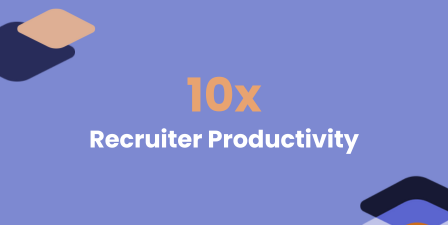At first glance, manual hiring processes might seem cost-effective. After all, why invest in new technologies when the current system "works"? No costs associated with new deployments, integrations, and driving adoption of new platforms. However, beneath the surface lies a series of hidden costs - time, money, and missed opportunities - that can significantly hinder a staffing company's growth and competitiveness in the years to come.
Time: The Unseen Expense
Time is a non-renewable resource, and in recruitment, delays can be costly. Recruiters at staffing firms often spend a significant portion of their week on tasks that could be automated:
- Resume Screening: Manually reviewing resumes can consume hours, especially when dealing with large pools of candidates.
- Interview Scheduling: Coordinating between candidates and clients often leads to prolonged email threads and scheduling friction.
According to LinkedIn's Future of Recruiting report, organizations that have integrated or are experimenting with generative AI tools report saving approximately 20% of their workweek.
For staffing firms, that time saved translates directly into more placements, more client value, and higher margins.
Financial Implications Beyond the Surface
While the direct costs of recruitment, such as recruiter time and job board fees, are clear, manual processes introduce hidden financial drag:
- Extended Time-to-Fill: When positions take longer to fill, staffing firms risk losing client trust and revenue.
- Client Attrition: Inefficient or outdated workflows can frustrate clients, resulting in churn or smaller scopes of work.
- Administrative Overheads: Manual resume formatting, feedback collection, and candidate tracking drive up overhead without increasing placements.
A report by the Society for Human Resource Management (SHRM) indicates that poor hiring decisions can cost clients upwards of $240,000 per hire when considering lost productivity, training, and turnover costs.
When a staffing firm’s workflows contribute to bad matches or slow fills, those client costs quickly become a reputational risk.
Candidate Experience: A Silent Deal-Breaker
Manual hiring workflows don’t just slow down internal processes; they create friction for candidates as well. And in a world where reputation drives referrals and re-engagement, the cost of a poor candidate experience is high:
- Delayed Responses: Without automation, follow-ups lag, and candidates drop out of the process.
- Lack of Transparency: Candidates are often left in the dark about where they stand or how they’re being represented.
- Fragmented Communication: Switching between email, spreadsheets, and PDF resumes creates gaps in messaging.
In 2025, candidates expect the same digital experience from staffing firms that they do from consumer tech. Falling short can damage your brand and your talent pipeline.
The Ripple Effect on Team Morale and Productivity
Manual workflows don’t scale. As demand increases, staffing firms often face a familiar dilemma: hire more recruiters or ask your current team to do more with less. Neither option is sustainable.
- Increased Workload: Recruiters bogged down in admin work have less time for client and candidate engagement.
- Burnout Risk: High-effort, low-leverage tasks erode morale and contribute to employee turnover.
- Stalled Growth: Firms find themselves growing headcount just to maintain output, rather than scaling revenue.
Automation isn’t just about doing more faster. It’s about preserving the energy, motivation, and strategic bandwidth of your team.
Embracing Automation: A Strategic Imperative
Adopting AI and workflow automation is no longer a “nice-to-have.” It’s a competitive necessity for modern staffing firms. The benefits extend far beyond time savings:
- Faster Fill Times: AI-powered matching accelerates sourcing and submission workflows.
- Higher Engagement: Automated touchpoints keep candidates warm and clients informed.
- Better Margins: Doing more with less means higher profitability without scaling headcount linearly.
Ultimately, the firms that thrive in the years ahead won’t just be good at recruiting. They’ll be great at operational efficiency. And that means leaving behind the manual methods of the past.






